Mills in Alto Aragón - harinero
Santa María de la Nuez
Santa María de la Nuez is a small nucleus
in the
Sobrarbe region and belongs to L'Ainsa which is 25 km away. Drop
your vehicle at the first houses where the road forms a little square. Then walk between the houses in a southward direction.
Follow the track to the South for about 500 m and you should then reach a bifurcation. Take the left branch (to the East, that is) which
gradually brings you down —with a barranco at your right and fields at your left side— into the valley of the Río Vero.
Then again to the South: walk in the river bed where the vegetation is too dense on the shoulder. You will reach the first
bend in the river after about 1 km. The mill is about 1.7 km away from the point where you entered the river bed.
Pictures: 14.viii.2015

(1) The mill of Casa Mur next to the Río Vero
Most of the construction did fall apart (2). The thick walls were built
from carefully rectangular cut stone. Two stones (3), burried between the rubble, can still be found : they are monoliths
made from pudding stone. The bed stone is visible from below, from the cárcavo, through
the opening in the roof for the axle. The runner stone is lying below the window and must have slid aside from its
original position.
There is a very narrow window opening in the wall
looking to the South (2). From the outside (1) it is clearly visible that this window is placed near the middle
of the wall. The opening is therefore not centered above the cárcavo —like in other small mills, e.g.
Abellada— and the light did not shine were the work was being done.
This must have been at least a bit impractical.
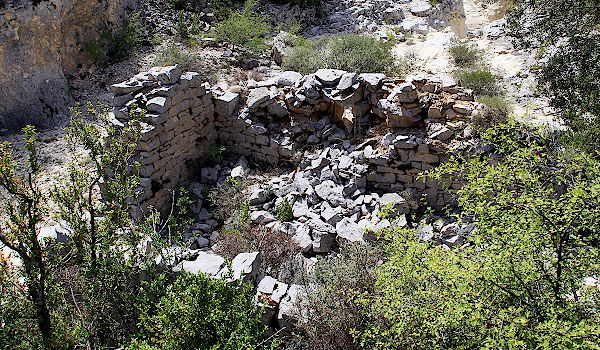
(2) Overview of the workplace. The stones were in the corner left.
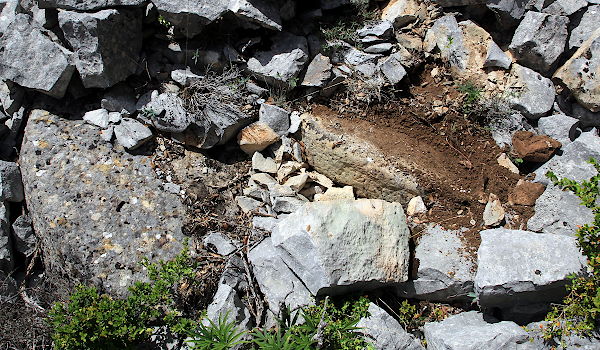
(3) Old runner stone (left); it is a monolith from pudding stone.
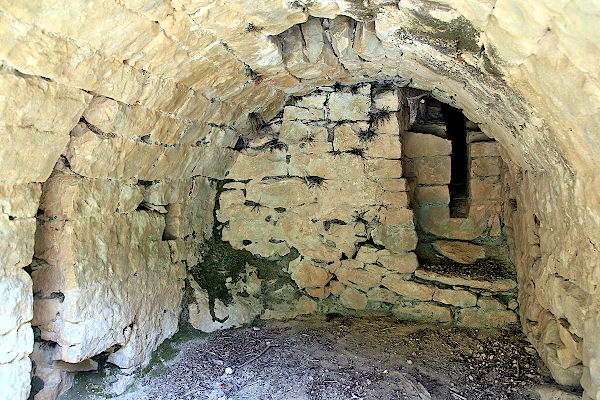
(4) Underhouse, cárcavo, with end of the pressure chute.
The underhouse, or cárcavo
, (4) is spacious and in perfect condition. Through the opening for the shaft, the bed stone can be seen. The most striking feature, however, is the
pressure pipe (5) in the back wall.
Notice how such a pressure pipe, saetín
,
is composed of individual stones. The bottom of the pipe (5) consists of a row of u-shaped cut stones.
It is remarkable how finely these stones are cut and also how deep the slit, while a simple tube could easily have sufficed.
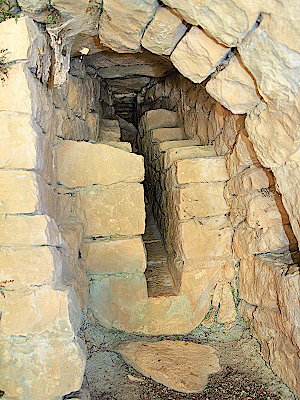
(5) End of the pressure chute
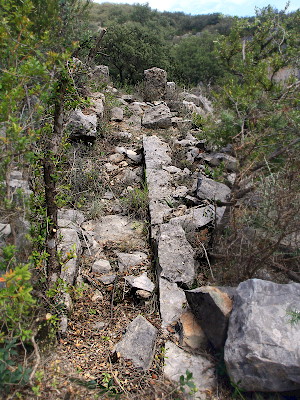
(6) Open chute
The structure raises some questions. If we consider the
position of the shaft which is easily 2 m more forward in the cárcavo then there
is no way the water jet could have hit the wheel. The device in its current state will not have produced
a true narrow water jet.
What would have worked is a wall that closed off the hollow space in which pressure could be built up.
A wooden nozzle, botana
, mounted on that wall, then would have produced a usable water jet.
It may be, however, that this deep and narrow chute is a more recent addition to the waterworks. A closer look (5) reveals that the mortar between the stones is more richly applied and more greyish
than elsewhere in the underhouse. Maybe a vertical wheel was placed in, or before, the gutter and this
wheel could then move, not the stones, but some lighter equipment, like for sharpening knifes and scythes.
We have seen (remains of) similar arrangements in
Alquézar,
Humo de Muro and
Lacabezonada.

(7) The mill with the open chute and the end of the canal.
The canal which carried the water from the pond around the corner
to the mill ends at a trio of huge stones (8, 9). Slots have been cut in the stones in which closing doors were fitted.
There was one door for the open chute to the mill and another one which made it possible to flush water
back to the river. The stone which both doors had in common features grooves on two of its faces —
see 9, bottom left.
Looking from the side (7, 8) it becomes clear how in the construction
of this mill the height differences of the terrain were put to maximum use.
The open gutter (6 – 8) is bordered with flat stones and at the bottom also with a row of large boulders.
What remains of the structure is built with such precision that I think there was no need for wood planks or metal sheets
— like in Ainielle— to make the chute watertight.
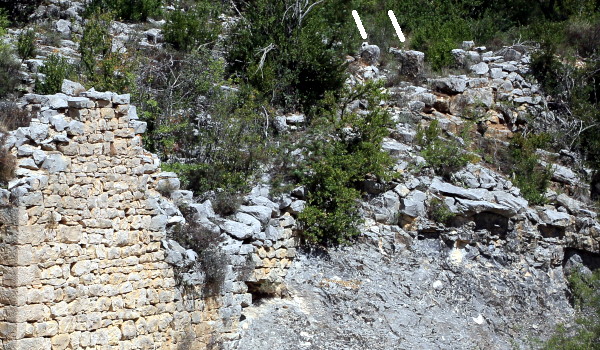
(8) The chute with the two corner stones (see 9) for the door.
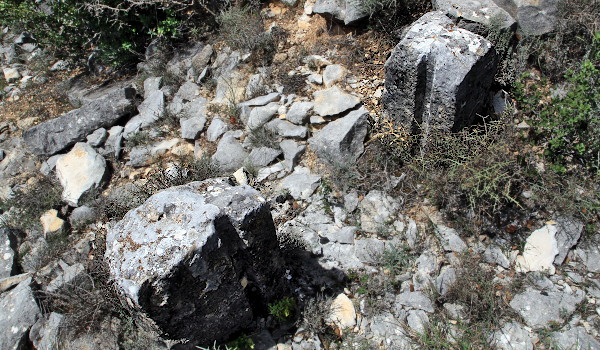
(9) Corner stones with slots for the doors to the chute and to the flush.
Going back from the top of the chute towards Santa María the canal
is easily traced back to the point where the dam must have been (10, 11). With a little effort some round holes
can be found under the moss between the vegetation. At the same height, but in the river bed, some
more holes (11) can be seen, which form a line crossing the river.
The excavations between the vegetation are round and rather narrow, destined to receive poles, but those in the river are more like squares with sides of about 40 cm —see horizontal white strokes in 11.
They were surely meant for larger beams for a timber dam. Some of the large holes have a smaller companion
at the side downstream —vertical stroke in 11. They must have held supporting poles which helped to counteract
the pressure of the water.

(10) The former mill pond.
Remains of another impressive dam which must have had beams
of 60 cm width can be seen in
Las Bellostas.
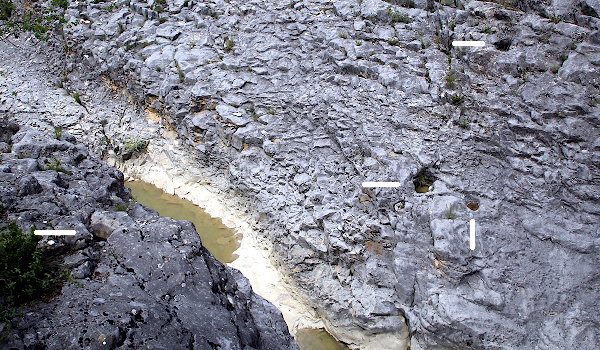
(11) Holes for the poles of the dam.
More about this mill of Casa Mur in:
A la búsqueda de molinos:
Escondido en el barranco del Río Vero
el Gurrión XI.2015, N° 141, p13–16 —
Download PDF (Spanish)












